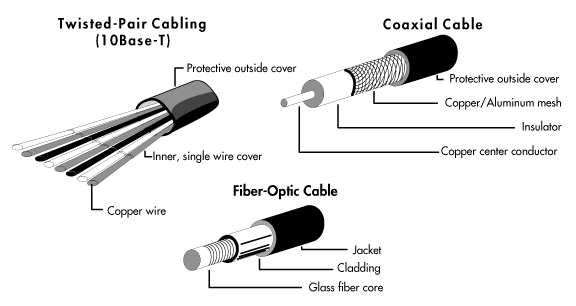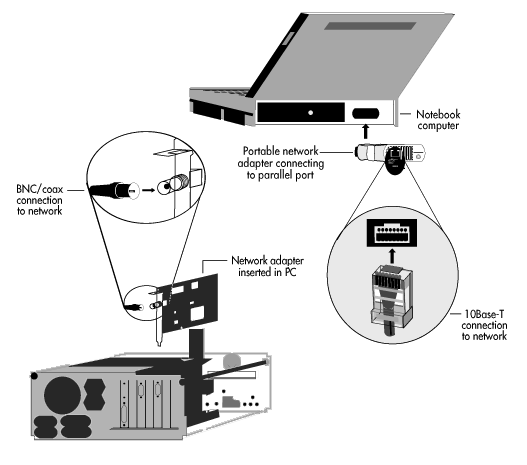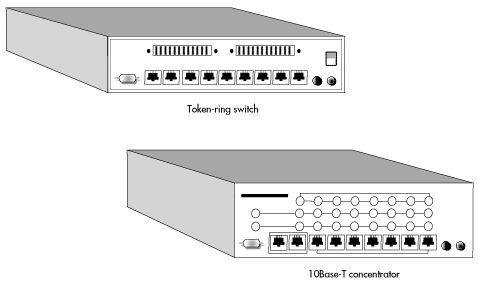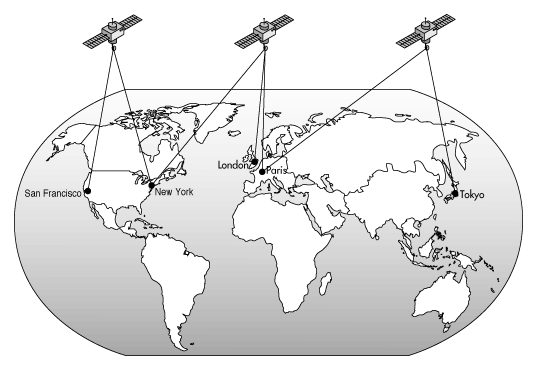The purpose of computer networks is to enable users to manipulate data so it can be stored, retrieved, and shared. To understand how available technology enables us to do this, we need to define a few terms and understand some basic concepts.
Although we routinely use the terms "data" and "information" interchangeably, they are not technically the same thing.
Data are entities that convey meaning. Computer data is stored as a series of electrical charges arranged in patterns to represent information. In other words, data refers to the form of the information (the electrical patterns). It is not the information itself.
Information means decoded data, in human-readable form. In other words, information is the real-world, useful form of data. For example, the data in an electronic file can be decoded and displayed on a computer screen or printed onto paper as a business letter.
To store meaningful information as data and to retrieve the information, we use an encoding schemeŚwe agree on a series of electrical patterns that will represent each of the discrete pieces of information we want to store and retrieve. For example, we agree that a particular series of electrical patterns will represent the alphabetic character "A." There are many encoding schemes in use. One common data-encoding scheme is ASCII code; an appendix at the end of this primer gives a description of the ASCII data code.
To encode information into data and later decode that data back into information, we use electronic devices (one of which is the computer) that generate electronic signals. Signals are simply the electric or electromagnetic encoding of data. Various components in a computer enable it to generate signals to perform the encoding and decoding task.
At the most general, conceptual level, to have a computer network we need only three components. First, we need a data code. Next, we need computers and auxiliary devices to encode information into data signals and to decode data signals back into information. Finally, we need the means to transfer the signals between the computer devices.
Let's suppose we've agreed on a coding scheme and we have several computers that are all capable of encoding and decoding the information we want to save.
Now, to have a computer network, we need only the means of transferring the generated signals between the computers. To transfer signals between the computers, we need two things: (1) a transmission medium to carry the signals and (2) devices to propagate (send) and receive the signals.
Electrical signals are generated as electromagnetic waves (analog signaling) or as a sequence of voltage pulses (digital signaling). To be propagated (sent) from one location to another, a signal must travel along a physical path. The physical path that is used to carry a signal between a signal transmitter and a signal receiver is called the "transmission medium."
There are two types of transmission media: guided media (bounded media) and unguided media (unbounded media).
Guided or bounded media are manufactured so that signals will be confined to a narrow path and will behave predictably. Commonly used guided media include twisted-pair wiring, similar to common telephone wiring; coaxial cable, similar to that used for cable TV; and optical fiber cable.
Figure 1: Common guided transmission media

Unguided or unbounded media are natural parts of the existing environment that can be used as physical paths to carry electrical signals. Earth's atmosphere and outer space are examples of unguided media that are commonly used to carry signals. These media can carry such electromagnetic signals as microwave and infrared light waves.
Regardless of the type of medium, the network signal is transmitted through it as some kind of waveform. When transmitted through wire and cable, the signal is an electrical waveform. When transmitted through fiber-optic cable, the signal is a light wave, somewhere in the spectrum of visible or infrared light. When transmitted through Earth's atmosphere or outer space, the signal can take the form of waves in the radio spectrum, including VHF and microwaves, or it can be light waves, including infrared or visible light (for example, lasers).
When planning a computer network, designers choose a transmission medium, or a combination of media, based on the physical circumstances involved in building the network and the reliability and data-handling performance required of the network. The objective is to keep costs to a minimum yet provide all parts of the network with the required reliability and performance.
For example, if you needed to build a network consisting of two subnetworks located in separate buildings several miles apart, you might use two or more transmission media. If you did not require the same level of performance on both subnetworks, you might use a different type of wire or cable as the transmission medium on each.
To connect the two subnetworks across town and ensure a reliable connection even in rain and fog, you might use a third medium, Earth's atmosphere, and connect the subnetworks through a microwave link. Or, you might use a T1 or T3 connection. T1 and T3 are dedicated lines (basically special telephone lines) that support high-speed communications. They can be leased from private companies that specialize in providing communication services.
Once you have a transmission medium, you need devices that can propagate signals across the medium and devices that can receive the signals when they reach the other end of the medium. There are a number of such devices used in computer networking. Such devices are designed to propagate a particular type of signal across a particular type of transmission medium. Transmitting and receiving devices used in computer networks include network adapters, repeaters, wiring concentrators, hubs, switches, and infrared, microwave, and other radio-band transmitters and receivers.
A network adapter or network interface card (NIC) is the hardware installed in computers that enables them to communicate on a network. Network adapters are manufactured in a variety of forms. The most common form is the printed circuit board, which is designed to be installed directly into a standard expansion slot inside a microcomputer. Other network adapters are designed for mobile computing. They are small and lightweight and can be connected to standard connectors on the back of portable (laptop and notebook) computers so that the computer and network adapter can be easily transported from network to network. Network adapters are now being built into many computers, especially portable and laptop computers.
Network adapters are manufactured for connection to virtually any type of guided medium, including twisted-pair wire, coaxial cable, and fiber-optic cable. They are also manufactured for connection to devices that transmit and receive visible light, infrared light, and radio microwaves, to enable wireless networking across the unguided media of Earth's atmosphere and outer space.
The connection hardware used to make connections between network adapters and different transmission media depends on the type of medium used. For example, twist-on BNC connectors are commonly used for connection to coaxial cable, while snap-in telephone-like RJ-45 jacks are ordinarily used for connection to twisted-pair wiring. Figure 2 shows two different types of network adapters connected to different computers and media, using different types of connectors.
Figure 2: Network adapters are manufactured in a variety of forms, for virtually every kind of communication medium.

Repeaters are used to increase the distance over which a network signal can be propagated.
As a signal travels through a transmission medium, it encounters resistance and gradually becomes weak and distorted. The technical term for this signal weakening is "attenuation." All signals attenuate, and at some point they become too weak and distorted to be reliably received. Repeaters are used to overcome this problem.
A simple, dedicated repeater is a device that receives the network signal and retransmits it at the original transmission strength. Repeaters are placed between other transmitting and receiving devices on the transmission medium, at a point where the signal will not have attenuated too much to be reliably received.
In today's networks, dedicated repeaters are seldom used. Repeating capabilities are built into other, more complex networking devices. For example, virtually all modern network adapters, hubs, and switches incorporate repeating capabilities.
Wiring concentrators, hubs, and switches provide a common physical connection point for computing devices. (We limit this discussion to devices used for making physical connections. The term "concentrator" can mean something different in a mainframe or minicomputer environment.) Most hubs and all wiring concentrators and switches have built-in signal repeating capability and thus perform signal repair and retransmission (along with other complex functions).
In most cases, hubs, wiring concentrators, and switches are proprietary, standalone hardware. There are a number of companies that manufacture such equipment. Occasionally, hub technology consists of hub cards and software that work together in a standard computer.
Figure 3 shows two common hardware-based connection devices: a token-ring switch and an Ethernet 10Base-T concentrator.
Figure 3: Token-ring switch and Ethernet 10Base-T concentrator

Microwave transmitters and receivers, especially satellite systems, are commonly used to transmit network signals over great distances. A microwave transmitter uses the atmosphere or outer space as the transmission medium to send the signal to a microwave receiver. The microwave receiver either relays the signal to another microwave transmitter, which sends it to another microwave receiver, or the receiving station translates the signal to some other form, such as digital impulses, and sends it along on some other suitable medium. Figure 4 shows a satellite microwave link.
Figure 4: Satellite microwave link

Infrared and laser transmitters are similar to microwave systems. They use the atmosphere and outer space as the transmission media and require a line-of-sight transmission path. The major difference is that they transmit light waves rather than radio waves. Infrared and laser transmissions are useful for signaling across short distances where it is impractical to lay cableŚfor instance, when networks are at sites a few miles apart. Because infrared and laser signals are in the light spectrum, rain, fog, and other environmental factors can cause transmission problems.
Modems convert digital (computer) signals to analog (audio) signals, and vice versa, by modulating and demodulating a carrier frequency. The most common modems transmit and receive data across ordinary voice-grade telephone lines.
A transmitting modem converts (MOdulates) the encoded data signal to an audible signal and transmits it. A modem connected at the other end of the line listens to the audible signal and converts it back into a digital signal (DEModulates it) for the computer on the receiving end of the communication link. Modems are commonly used for inexpensive, intermittent communications between geographically isolated computers and a main network.